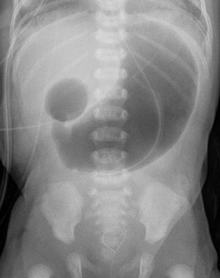| Duodenal atresia | |
|---|---|
 | |
| Radiograph of abdomen with double-bubble sign from duodenal atresia | |
| Specialty | Pediatric gastroenterology, Pediatric surgery |
| Symptoms | Antenatal period: polyhydramnios Neonatal period: bilious or non-bilious vomiting within first 36 hours of life, abdominal distension, lack of stooling |
| Usual onset | During embryological development |
| Causes | Unknown |
| Risk factors | Down syndrome |
| Differential diagnosis | annular pancreas, duodenal stenosis |
| Treatment | nasogastric suction, surgery (duodenoduodenostomy) |
Duodenal atresia is the congenital absence or complete closure of a portion of the lumen of the duodenum. It causes increased levels of amniotic fluid during pregnancy (polyhydramnios) and intestinal obstruction in newborn babies. Newborns present with bilious or non-bilous vomiting (depending on where in the duodenum the obstruction is) within the first 24 to 48 hours after birth, typically after their first oral feeding. Radiography shows a distended stomach and distended duodenum, which are separated by the pyloric valve, a finding described as the double-bubble sign.
Treatment includes suctioning out any fluid that is trapped in the stomach, providing fluids intravenously, and surgical repair of the intestinal closure.